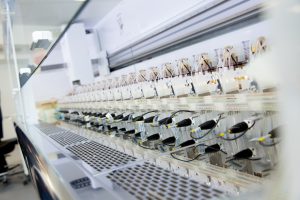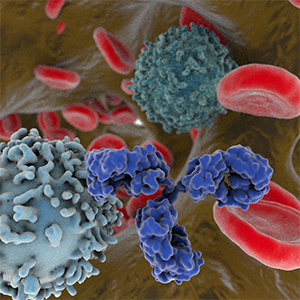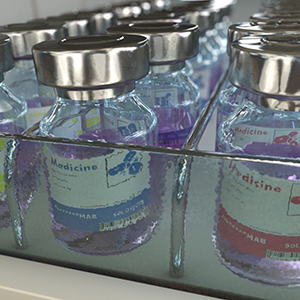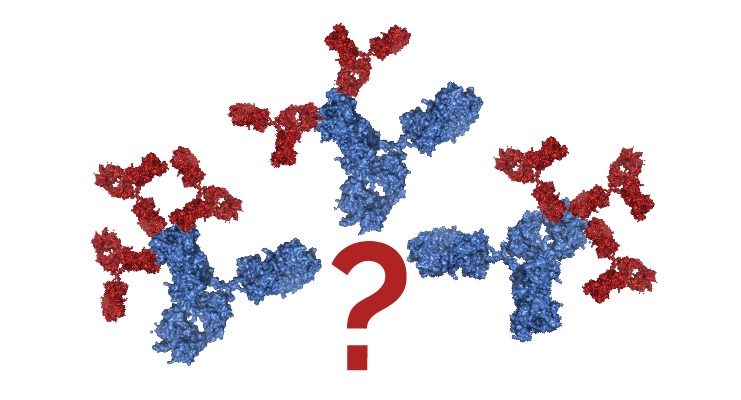Defeating the coronavirus pandemic will require unprecedented cooperation from the research community. This is especially true for the Adaptive Immune Receptor Repertoire Community (AIRR-C), given the paramount importance of antibodies and T cells for vaccines, diagnostics, and therapeutics in viral infection. Therefore, the AIRR-C hereby calls upon its members, and the wider research community, to share experiences, resources, samples, and data as openly and freely as possible, and to work within their respective systems to break down barriers to achieve this goal, subject to the overarching directives of respect, privacy, and protection for patients and all people. We are in this together.
Molecular Biology Can Improve Antibody Drug Developability
 Contributed by Nick Hutchinson, FUJIFILM Diosynth Biotechnologies
Contributed by Nick Hutchinson, FUJIFILM Diosynth Biotechnologies
The discovery and development of antibody therapeutics often adheres to a series of stages starting with target identification and progressing through lead generation, lead optimization, then testing in preclinical and clinical studies. Molecular biologists engineer antibodies during lead generation and optimization to improve a range of characteristics, including antibody specificity and potency, or to reduce immunogenicity and the rate of elimination from the body (1).
Next-generation antibody biopharmaceuticals include bispecifics, glyco-engineered antibodies and antibody-fusion proteins with complex architectures. While drug development scientists may use antibody engineering techniques to generate candidates with very desirable or improved functional properties, at the same time, these can alter the biochemical, biophysical and in vivo properties of the antibody candidate, which can be detrimental to the overall target product profile (2). Engineering antibodies to improve their functional properties is frequently performed without consideration for the subsequent developability, including manufacturability, of the molecule. These issues are then often identified at a relatively late stage in the discovery process, after substantial resources have been invested in the molecule and, therefore, can have a real financial impact on drug development companies that may be being kept alive by funding from investors.
Ideally, antibody therapeutics should be capable of being manufactured with high productivity and at high quality with low protein heterogeneity. From a developability perspective, it is preferable if they express to high titer from the mammalian cell expression system and are stable during production storage and delivery (1). Some antibody candidates can exhibit a propensity to partially unfold, revealing hydrophobic patches that are more normally buried inside the molecule. Once revealed, the patches can interact with one another, leading to aggregation. Other liabilities that reduce developability include low solubility, unstable amino acids, clipping and antibody fragmentation (1). These can be sufficiently severe that projects can be cancelled due to poor toxicology data and concerns around whether the candidate can be safely administered to patients during clinical trials.
One solution, advocated by investigators from Roche (2), is to assess developability during antibody drug discovery. Their workflow incorporates two separate assessments, the first following the initial candidate screening and selection and the second following humanization and re-engineering, but before the selection of the clinical lead. During the first phase of the assessment, complementarity-determining regions are analysed in silico for potential liabilities such as degradation sites. This can be followed by studies on stressed samples, with samples incubated at elevated temperatures for two weeks. Stable candidates can progress to the next stage or drug development scientists can use humanization and protein re-engineering to remove the identified liabilities. The second phase, which follows humanization, again employs in silico tools but evaluates the whole humanized molecule and assesses potential hotpots where post-translational modification, charge variations or degradation might occur. Researchers then perform a second stress test for the most likely or detrimental liabilities. During this phase, they can include tests for self-interaction and aggregation, such as apparent hydrophobicity by hydrophobic interaction chromatography, thermal stability by dynamic light scattering (DLS), protein-protein self-interaction by DLS and viscosity at high concentration by DLS with latex beads (2).
Other groups have gone further, and not only select for candidates with properties that limit manufacturing and storage risks, but also apply molecular engineering techniques in order to improve manufacturability proactively. For example, in 2019, a team from AstraZeneca described manufacturing challenges they encountered during downstream purification of an antibody that was undergoing liquid-liquid phase separation (3). This in turn resulted in the need for longer mixing times that can be damaging for proteins, yield losses, increases in pressure during processing and misleading analytical results from in-process samples. The team attempted to resolve the problem by optimize the bioprocessing conditions, but there were still substantial limitations to large-scale manufacturing. To fix the problem, they used in silico homology modelling and charged-patch analysis to identify problematic residues, and this ultimately lead them to substitute charged residues with those with a neutral or opposite charge. Their research showed that these substitutions minimized electrostatic interactions and allowed them to engineer a variant that maintained antigen-binding affinity, but eliminated the liquid-liquid phase separation behaviour.
The molecular engineering of therapeutic antibodies is allowing development of candidates with ever improved functional properties. However, researchers should consider, where possible, the impact of this engineering on the biochemical and biophysical characteristics of the molecule, which can have a negative effect on the developability of lead candidates. Incorporating screens for developability during drug discovery workflow can help eliminate candidates with liabilities that will prevent them from being successful drugs. The more sophisticated developers of antibody therapeutics are cleverly applying molecular biological techniques to improve the stability and manufacturability of their monoclonal antibody leads.
(1) Chiu, M.L. & Gilliland, G.L. (2016) Engineering antibody therapeutics. Current Opinions in Structural Biology, 38: 163-173.
(2) Jarasch, A., Koll, H., Regula, J.T., Bader, M., Papadimitriou, A. & Kettenberger, H. (2015) Developability assessment during the selection of novel therapeutic antibodies. Journal of Pharmaceutical Sciences, 104:1885-1898.
(3) Du, Q., Damschroder, M., Pabst, T.M. Hunter, A.K., Wang, W.K. & Luo, H. (2019) Process optimization and protein engineering mitigated manufacturing challenges of a monoclonal antibody with liquid-liquid phase separation issues by disrupting inter-molecule electrostatic interaction. MAbs, 11 (4): 789-802.
The Antibody Society is an authoritative source of information about antibody therapeutics development. We are pleased to provide original posts and news summaries on our homepage, as well as semi-monthly summaries of recent news to our members. Archived news from 2019 can be found in the Web Resources section of the Society’s website.
FDA approves isatuximab-irfc for multiple myeloma
 On March 2, 2020, the U.S. Food and Drug Administration (FDA) approved Sarclisa (isatuximab-irfc), in combination with pomalidomide and dexamethasone, for the treatment of adult patients with multiple myeloma who have received at least two prior therapies including lenalidomide and a proteasome inhibitor. FDA granted isatuximab Orphan Drug designation for multiple myeloma. Developed by Sanofi, isatuximab (SAR650984) is a chimeric IgG1 antibody directed against CD38 expressed on malignant plasma cells. The antibody acts through a combination of mechanisms, which may depend on the expression level of the target.
On March 2, 2020, the U.S. Food and Drug Administration (FDA) approved Sarclisa (isatuximab-irfc), in combination with pomalidomide and dexamethasone, for the treatment of adult patients with multiple myeloma who have received at least two prior therapies including lenalidomide and a proteasome inhibitor. FDA granted isatuximab Orphan Drug designation for multiple myeloma. Developed by Sanofi, isatuximab (SAR650984) is a chimeric IgG1 antibody directed against CD38 expressed on malignant plasma cells. The antibody acts through a combination of mechanisms, which may depend on the expression level of the target.
The approval was based on the results of the Phase 3 ICARIA-MM study (NCT02990338) demonstrating a statistically significant improvement in progression-free survival (PFS). This study included 307 patients with relapsed and refractory multiple myeloma who had received at least two prior therapies, including lenalidomide and a proteasome inhibitor. Patients who received Sarclisa in combination with pomalidomide and low-dose dexamethasone showed improvement in PFS, with a 40% reduction in the risk of disease progression or death compared to patients who received pomalidomide and dexamethasone. These patients also had an overall response rate of 60.4%. Patients who only received pomalidomide and low-dose dexamethasone had an overall response rate of 35.3%.
The European Medicines Agency is currently evaluating a marketing authorization application for isatuximab for the treatment of relapsed/refractory multiple myeloma.
The Antibody Society maintains a comprehensive table of approved monoclonal antibody therapeutics and those in regulatory review in the EU or US. The table, which is located in the Web Resources section of the Society’s website, can be downloaded in Excel format. Information about other antibody therapeutics that may enter regulatory review in 2020 can be found in ‘Antibodies to watch in 2020’.
Like this post but not a member? Please join!
FDA approves eptinezumab-jjmr for preventative treatment of migraine
 H. Lundbeck A/S has announced that Vyepti™ (eptinezumab-jjmr) was approved by the U.S. Food and Drug Administration for the preventive treatment of migraine in adults and will be available in April 2020. The recommended dosage is 100 mg as an intravenous infusion over approximately 30 minutes every 3 months; some patients may benefit from a dosage of 300 mg. Lundbeck expects to submit eptinezumab for approval to regulatory authorities in the European Union during 2020, followed by submissions for approval in other regions. Development of eptinezumab was initiated by Alder BioPharmaceuticals, Inc., which was acquired by Lundbeck in October 2019.
H. Lundbeck A/S has announced that Vyepti™ (eptinezumab-jjmr) was approved by the U.S. Food and Drug Administration for the preventive treatment of migraine in adults and will be available in April 2020. The recommended dosage is 100 mg as an intravenous infusion over approximately 30 minutes every 3 months; some patients may benefit from a dosage of 300 mg. Lundbeck expects to submit eptinezumab for approval to regulatory authorities in the European Union during 2020, followed by submissions for approval in other regions. Development of eptinezumab was initiated by Alder BioPharmaceuticals, Inc., which was acquired by Lundbeck in October 2019.
Eptinezumab-jjmr is a humanized immunoglobulin G1 (IgG1) monoclonal antibody specific for calcitonin gene-related peptide (CGRP) ligand. It is produced in Pichia pastoris yeast cells by recombinant DNA technology. The safety of VYEPTI was evaluated in over 2000 patients with migraine who received at least one dose of the drug. The approval was supported by positive results from the PROMISE 1 (NCT02559895) and PROMISE 2 (NCT02974153) Phase 3 clinical trials, which investigated eptinezumab for episodic and chronic migraine prevention, respectively. In PROMISE-1, a total of 665 patients were randomized to receive placebo (N=222), 100 mg Vyepti (N=221), or 300 mg Vyepti (N=222) every 3 months for 12 months. Mean migraine frequency at baseline was approximately 8.6 migraine days per month and was similar across treatment groups; mean change from baseline in monthly migraine days (MMD) with Vyepti compared with placebo months 1-3 was -3.9 days for 100 mg (p=0.018), -4.3 days for 300 mg (p<0.001), and -3.2 days for placebo. In PROMISE-2, a total of 1,072 patients were randomized to receive placebo (N=366), 100 mg Vyepti (N=356) or 300 mg Vyepti (N=350) every 3 months for 6 months. Mean migraine frequency at baseline was approximately 16.1 migraine days per month and was similar across treatment groups. Mean change from baseline in MMD compared with placebo months 1-3 was -7.7 days for 100 mg (p<0.001), -8.2 days for 300 mg (p<0.001), and -5.6 days for placebo
The Antibody Society maintains a comprehensive table of approved monoclonal antibody therapeutics and those in regulatory review in the EU or US. The table, which is located in the Web Resources section of the Society’s website, can be downloaded in Excel format. Information about other antibody therapeutics that may enter regulatory review in 2020 can be found in ‘Antibodies to watch in 2020’.
Like this post but not a member? Please join!
Everything you ever wanted to know about Antibody Validation
 All webinars in our Antibody Validation series are now On Demand!
All webinars in our Antibody Validation series are now On Demand!
Tool antibodies are the dominant affinity reagent for proteomics in cell biology, reflected by the over 4.5 million antibodies that are commercially available. Distinct from therapeutics or diagnostics, tool antibodies tend to be poorly characterized. This is echoed by many reports of catastrophic specificity, activity, identity and reporting deficits involving such reagents.
Nevertheless, biological sciences remain highly dependent on them.
In a 10-part series, aimed especially at those beginning a career in biological sciences,The Antibody Society has invited leaders in antibody research from industry and academia to reflect on antibody validation. They paint a uniformly alarming picture of inadequacies at many levels – which encourages users to be highly aware of the consequences of inadequate tool antibody validation, which threaten their biological endeavors.


